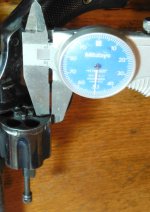CAUTION: The following post includes loading data beyond or not covered by currently published maximums for this cartridge. USE AT YOUR OWN RISK. Neither the writer, The Firing Line, nor the staff of TFL assume any liability for any damage or injury resulting from use of this information.
I have blown up a number of revolvers.
1) Split the cylinders on (3) 38 specials and (1) 32 S&W Long.
The 32 S&W Long was a Colt pocket positive over 100 years old, using a case full of fast powder, and not working up.
Quickload thinks the load was 98,000 psi, which is meaningless.
I have been getting very high velocities with a 100+ year old Colt 32 S&W Long, over 1400 fps with 85 gr bullets. That is using a slow powder, LIL'GUN or 800X. I am not getting great groups. The little revolver kicks.
The cylinder splitting has to do with pressure, wall thickness, stress rising cracks, and inside diameter. It is a very complicated equation to calculate the stress in the steel open ended tubes per Roark's formulas. Those don't even work, as the outside of a chamber is not symmetrically round. But to a first order the stress is proportional to the pressure times the inside diameter divided by the wall thickness. The critical wall thickness is the either the chamber to chamber or chamber to outside, which ever is thinnest.
In the 32 S&W long made in 1907 in the picture that does 1400 fps, the inside diameter is 0.34" while the thickness to the outside is 0.050"
That ratio better than J frame 357 mag revolvers and WAY better than a Ruger Blackhawk 45 Colt.
So with those thicknesses, I am not afraid to work up to the threshold of sticky cases with slow powder in that old revolver. Not afraid of cylinder splitting.
When cylinders split, the pieces go right, left, or up. I have never been hit when shooting. But I have made big holes in wood and metal when the parts went to the right. Don't stand next to anyone trying to split a cylinder. Semi auto pistols and bolt action rifles can throw parts and gas backwards. I hold those differently in testing.
But wait, there's more..
There other things that can get wrecked on a revolver besides cylinder splitting:
2) The bolt the fits in a slot in the frame and fits in a slot in the cylinder during firing, can see stress if the bullet strikes the forcing cone off center. That puts a torque on the cylinder and can open the size of the slot in either or both the frame and cylinder. That makes rotational sloppiness, so the subsequent shots can be even MORE off center. Colts tend to be right on, tight, and stay tight. Smiths start tight, and with a little abuse they get sloppy. Rugers come sloppy from the factory. I have done this with (2) revolvers and bought lots of revolvers that came with this problem.
3) The frame can bend. I have done that once to an Aluminum frame revolver with triple loads.
4) End shake. The cylinder can get loose front to back. I have bought revolvers with this problem
5) The forcing cone can blow out. This has happened to me (3) times with 327 Federal type loads in a 100 year old Colt 32 S&W Long revolvers. Each time I TIG welded up the forcing cone, and re cut it thicker. The repaired thick ones have never failed.


